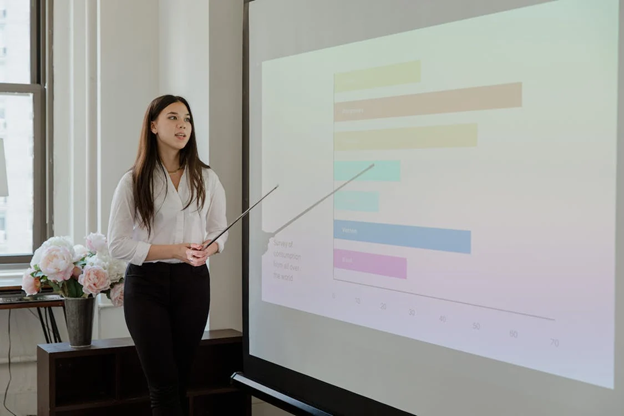A communication gap is when people in your organization cannot reliably understand one another because of language barriers, cultural nuance or unsuitable media. Closing that gap requires an integrated set of language services—professional translation, transcreation, voiceovers, interpretation and transcription—paired with process changes and live, instructor-led language training where appropriate.
What Is The Communication Gap And Why Does It Matter?
The communication gap appears when messages fail to travel clearly between employees, partners or customers. In multilingual workplaces, this is often caused by language barriers, inconsistent terminology or failures to adapt messages for different media (documents, video, live meetings). Left unaddressed, the gap reduces productivity, erodes inclusion and increases safety and compliance risk.
Research shows poor communication slows teams and increases hidden costs. For a practical management perspective, see the Harvard Business Review’s analysis of how poor communication harms team performance.
Which Language Services Close Language Barriers?
Effective language strategy pairs the right service to the right objective. Below are the core language-service modalities and how each reduces the communication gap.
Professional Translation
What it is: Converting written content from one language into another while preserving accuracy, terminology and intended meaning.
When to use it: Policies, procedures, manuals, HR documents, product documentation and website content that must be reliably understood by multilingual audiences.
Why it closes the gap: Translation ensures that every stakeholder receives the same factual information in their preferred language—reducing misunderstandings and compliance risk. Learn more about Workplace Languages’ professional translation services and workflows on our Translation page.
Transcreation
What it is: Creative adaptation of content so the message, emotion and brand voice resonate in the target language and culture.
When to use it: Marketing, branding, internal campaigns and any content that must persuade or build emotional connection.
Why it closes the gap: Literal translation can leave creative messages flat or off-brand. Transcreation preserves impact while removing cultural friction—critical when your message must move people, not just inform them. See our broader Language Services overview for transcreation as part of a full service suite.
Voiceovers And Subtitling
What they are: Voiceovers replace spoken audio with native-language narration; subtitling provides translated text synchronized with the original audio.
When to use them: Training videos, safety briefings, product demos and customer-facing multimedia.
Why they close the gap: Multimedia often communicates complex concepts quickly; adapting audio and captions ensures comprehension across language groups. See Workplace Languages’ Voiceovers offering for localization best practices.
Interpretation (Including Over-The-Phone Interpretation)
What it is: Real-time spoken language support for meetings, training sessions, negotiations and customer interactions. Over-the-phone interpretation (OPI) provides immediate access to interpreters when in-person support is not feasible.
When to use it: Live events, HR interviews, disciplinary meetings, multilingual town halls and customer service calls.
Why it closes the gap: Interpretation enables two-way, synchronous understanding—removing real-time barriers to participation. Review our interpretation services and OPI use cases on the Workplace Languages Interpretation page and learn more in this article: How Over-The-Phone Interpretation Supports Customer Service.
Transcription
What it is: Converting audio or video into written text in the same or a different language.
When to use it: Meeting notes, interviews, training archives and any scenario where a written record improves clarity or accessibility.
Why it closes the gap: Transcripts make spoken content searchable, auditable and available for translation—helpful when teams need to review or translate recorded conversations. Learn more about our transcription offerings.
How Do These Services Work Together To Close The Communication Gap?
A single service rarely solves systemic language challenges. Use this practical, step-by-step framework to design a program that closes the gap:
- Map Language Needs. Identify languages spoken by employees, clients and partners. Use internal surveys and HR data to quantify need and exposure.
- Prioritize High-Risk Channels. Rank channels by impact: safety materials, HR policies, legal docs, frontline customer support and executive communications.
- Match Services To Objectives. Assign translation to static critical documents; choose transcreation for marketing; schedule interpretation for live events; use transcription for archival and translation-ready records.
- Localize And Validate. Engage credentialed linguists who know industry terminology and cultural nuance. Local validation (in-market reviewers or subject-matter experts) reduces errors and cultural missteps.
- Integrate Into Workflows. Embed multilingual review checkpoints into your content lifecycle and align language tasks with HR and training calendars. Consider pairing language services with live, instructor-led language training for recurrent team needs.
- Measure And Iterate. Track metrics: comprehension on post-training assessments, incident rates in multilingual settings, employee engagement by language group and customer satisfaction for language-diverse segments. Use results to refine priorities and budgets.
The Society for Human Resource Management highlights practical steps HR can take to manage multilingual workforces and reduce language barriers—use that research to inform your assessment and prioritization.
Which Objectives Match Which Service? (Quick Comparison)
| Objective | Recommended Service | Primary Benefit |
|---|---|---|
| Ensure staff understand safety manuals | Professional Translation | Accurate, consistent compliance documentation |
| Launch an ad campaign in a new market | Transcreation | Message that resonates culturally and preserves brand voice |
| Run a global webinar | Interpretation + Translated Materials | Real-time understanding plus reference documents |
| Localize training videos | Voiceovers & Subtitling | Accessible multimedia for multilingual learners |
| Document meeting audio | Transcription + Translation | Searchable records accessible across languages |
How A Language-Service Partner Strengthens Trust And Performance
Selecting a specialist partner such as Workplace Languages reduces the risk of mistranslation, protects brand reputation and speeds rollout across languages. Specialist providers bring:
- Industry-tested quality assurance and review processes.
- Networks of credentialed linguists with subject-matter expertise.
- Operational integration so language work fits existing HR, communications and training workflows.
McKinsey’s recent work on inclusive organizations demonstrates that inclusion and performance are linked; linguistic inclusion is a practical lever within broader DEI efforts.
Practical Steps HR Leaders And Managers Can Take This Quarter
- Inventory critical documents and media. Identify the top 10 items that, if misunderstood, would cause the most harm or cost.
- Run a short language-needs survey. Ask employees what languages they prefer for safety, HR, and training content.
- Pilot with high-impact content. Translate one high-risk document, localize one training video (voiceover or subtitles), and provide interpretation for one all-hands meeting.
- Measure comprehension and satisfaction. Use quick post-session checks or short surveys to confirm the pilot’s impact.
- Roll out a roadmap. Scale based on ROI and risk—prioritize safety and legal compliance first, then customer experience and engagement.
For detailed practical guidance on overcoming language barriers and improving multilingual team efficiency, see our article on overcoming language barriers in the workplace. Overcoming Language Barriers.
How To Measure Success When You Close The Communication Gap
Meaningful metrics for HR and operations teams include:
- Comprehension rates on post-training quizzes by language group
- Change in incident or error rates in multilingual settings
- Employee engagement and retention among non-native English speakers
- Customer satisfaction among language-diverse customer segments
- Time saved resolving language-related support tickets
Use these metrics to build a business case for continued investment in translation, transcreation, voiceovers, interpretation and transcription.
Why Workplace Languages?
Workplace Languages provides a full suite of business language services (translation, interpretation, voiceovers, transcription and more) combined with live, instructor-led online training and onsite solutions. Explore our company homepage and service pages to see relevant case studies and offerings:
- Language Services Overview
- Multilingual Solutions
- Business Language Services
- Translation And Interpretation: Unique Roles
- Voiceovers
- Interpretation Services
- Translation Services
Frequently Asked Questions
What Is The Difference Between Translation And Transcreation?
Translation converts text accurately from one language to another. Transcreation adapts messaging to preserve tone and emotional impact so it resonates culturally in the target market.
When Should I Use Interpretation Versus Translation?
Use translation for static materials (documents, web pages). Use interpretation for live, spoken interactions where participants need real-time language support.
Do I Need Voiceovers And Subtitles For Training Videos?
Choose voiceovers when listeners should hear the message in their language. Use subtitles when keeping the original audio matters (for authenticity or speaker recognition). Combining both increases accessibility and user preference coverage.
How Can We Measure Improvement After Implementing Language Services?
Track comprehension scores, incident rates, employee engagement among language groups, and customer satisfaction in language-diverse segments. Tie improvements to reduced incidents, faster resolution times and higher engagement scores.




